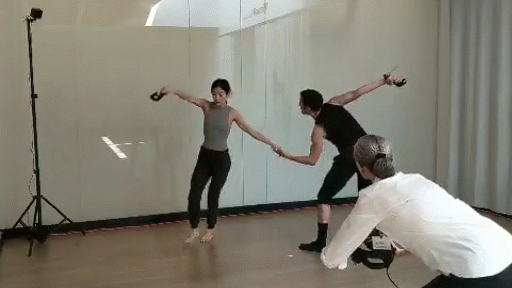In a yoga studio on the 11th floor of Google New York, dancer Lorenzo Pagano performed a modern piece he’d choreographed, with roles for four dancers. But this wasn't your ordinary piece of modern dance—through the use of technology, Lorenzo is dancing all the parts. With a Perception Neuron tracking suit, Lorenzo can record his movements as an avatar, and through virtual reality, he can watch his piece from any angle and in several backgrounds.
Pagano was among the dancers visiting from the Martha Graham Dance Company as part of a two-week Artist in Residency program through Google Arts & Culture. This latest endeavor had a simple aim: to bring dance, artists and technologists together to see what they can create.
Google Arts & Culture provides technical and developmental support, tools, and facilities to members of the Artist in Residency program. Working with Google technologists, Pagano and other company members explored how virtual reality and other technology might be applied to their craft. For example, some dancers wore full-body suits to track their movements and create virtual avatars in real time—a process that can help choreographers envision, tweak, and teach their pieces.
One of the first tools in hand was Tilt Brush, a Google VR tool that lets you paint in 3D space. With it, the dance troupe tried out some creative approaches to choreography. One member of the company, Xin Ying, created a duet inspired by the Chinese concept of yin and yang, where two dancers use their movement to paint a sculpture with Tilt Brush. To do so, she had to think about movement in a whole new way. “On stage, the movements would just disappear into the air,” Ying recounts. “With Tilt Brush, it became 3D art that lasted after the dance was finished.”

The goal of the residency was to create a new piece of art; along the way, the dancers realized the technology could be equally useful in helping them learn from what they create. Traditional cameras capture 2D motion from the audience’s point of view, which presents a challenge to performers, who have to think about all of the movements in reverse. Virtual reality headsets allow dancers to step into a role and really understand it, even walking around a piece they have recorded in order to see it from all angles.
The Martha Graham residency marks the first time that Google Arts & Culture has hosted dancers as artists in residence, and the first residency in New York City. Across the Atlantic and at the Google Arts & Culture Lab’s home in Paris, artists have been meeting for years with Google’s computer engineers to explore new ideas together. Last year, artist Jonathan Yeo unveiled a bronze sculpture modeled off of an AR piece created using Tilt Brush. Recently, the Lab unveiled new uses of machine learning in the art world, including Art Palette, which uses a combination of computer vision algorithms to match artworks with a color palette of your choosing.
“No artist is ahead of his time,” Martha Graham once said. “He is his time.” And by tapping into the technology of our time, we're excited to see what these dancers and artists can do.